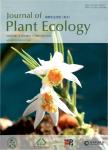Effects of environmental conditions and space on species turnover for three plant functional groups in Brazilian savannas
作者机构:Universidade do Estado de Mato GrossoCampus Universitário de Nova XavantinaRua Prof.Dr.Renato Figueiro VarellaCaixa Postal0878690-000Nova XavantinaMTBrazil Instituto de Pesquisa Ambiental da AmazôniaRua Horizontina 10478640-000CanaranaMTBrazil Centro de Ciências Biológicas e da NaturezaUniversidade Federal do AcreCaixa Postal 50069920-900Rio BrancoACBrazil Departamento de ZoologiaUniversidade de Brasília70910-900BrasíliaDFBrazil
出 版 物:《Journal of Plant Ecology》 (植物生态学报(英文版))
年 卷 期:2019年第12卷第6期
页 面:1047-1058页
核心收录:
学科分类:0710[理学-生物学] 071001[理学-植物学] 07[理学]
基 金:G.R.C.thanks Coordenacao de Aperfeicoamento de Pessoal de Nível Superior–CAPES(88881.068430-2014-01) Conselho Nacional de Desenvolvimento Científico e Tecnológico–CNPq(457587-2012-1) Fundacao de ApoioàPesquisa do Distrito Federal–FAPDF and the USAID’s PEER program under cooperative agreement AIDOAA-A-11-00012 for financial support
主 题:environmental gradient spatial gradient Neotropical savannas ecological tension zone life forms ecological groups
摘 要:Aims Different plant functional groups display diverging responses to the same environmental ***,we assess the effects of environmental and spatial predictors on species turnover of three functional groups of Brazilian savannas(Cerrado)plants—trees,palms and lianas—across the transition zone between the Cerrado and Amazon biomes in central *** We used edaphic,climatic and plant composition data from nine one-hectare plots to assess the effects of the environment and space on species turnover using a Redundancy Analysis and Generalized Dissimilarity Modeling(GDM),associated with variance *** Findings We recorded 167 tree species,5 palms and 4 liana *** variation was most important in explaining species turnover,relative to geographic distance,but the best predictors differed between functional groups:geographic distance and silt for lianas;silt for palms;geographic distance,temperature and elevation for *** distances alone exerted little influence over species turnover for the three functional *** pure environmental variation explained most of the liana and palm turnover,while tree turnover was largely explained by the shared spatial and environmental *** effects of geographic distance upon species turnover leveled off at about 300 km for trees,and 200 km for lianas,whereas they were unimportant for palm species *** results indicate that environmental factors that determine floristic composition and species turnover differ substantially between plant functional groups in ***,we recommend that studies that aim to investigate the role of environmental conditions in determining plant species turnover should examine plant functional groups separately.



